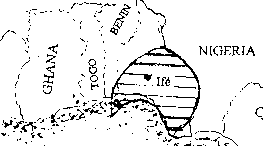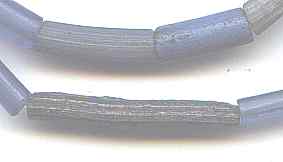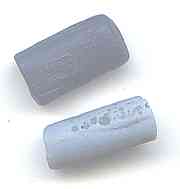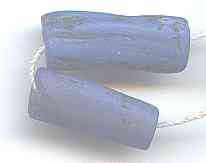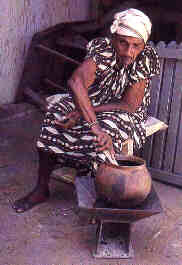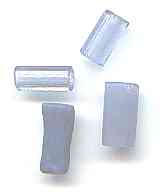The Bead SiteHome>Bead Names>Africa > The Aggrey Bead
The Aggrey Bead and itís Namesakes
For centuries, the Muslim merchants of North Africa crossed the Sahara to cities in West African kingdoms to trade for slaves and, above all, gold. What did they exchange?
In the 12th century Yakut said the merchants took, "salt, bundles of pine wood, blue glass beads, bracelets of red copper, bangles and signet rings of copper and nothing else." (Levitson and Hopkins 1981: 69, emphases mine)
|
Cori and its cognates became a staple of the trade. For the next four centuries European visitors to the Gold Cost wrote about it. They didn't always agree on what it was or even what it should be called, but their comments are instructive:
Approximate date of observation (others are dates of publication) * Secondary source
Full references and citations are in Margaretologist 3(2),1990
Several things should be explained. There is a blue coral in the local waters, but it could hardly have been made into beads, nor are any such known. "Coral" is the word for bead in several languages, including Dutch, from whom many of these writers got their information. These travelers were no better at distinguishing glass from stones as many people are today.
The name of the bead changed over time. In the 16th century it was cori, becoming accori in the 17th (the Fante, who live near El Mina, tend to put a vowel at the beginning of a word starting with a consonant). In the early 18th century, both Barbot and Bosman say that the natives called the bead accori, but that the Europeans called it aggrey, which became the standard name.
As long as the beads were being imported, the source was always to the east of Ghana. Importing had stopped by the early 19th century and the sources were then in Ghana. The Phoenician origin was based on the mistaken impression that chevrons, thought then to be Phoenician, were Aggrey beads.
The reprehensible Bowdich threw the most mud into people's eyes. His account was widely read and his description of "aggrey" beads was simply a list of all the important beads the Asante (Ashanti) owned. After him, chevrons and all sorts of other beads were mistakenly called "aggrey."
Up until Bowdich, nearly everyone agreed that the bead was blue. Brun took a closer look and saw it was dichroic: blue by reflected light and green by transmitted light. This was echoed by the Portuguese Emmanuel Ximenes, who asked the great glassmaker Antonio Neri in the early 16th century how to make dichroic blue/green glass to imitate a "stone" bead popular on the Gold Coast (Zecchin 1964:24)
What does archaeology tell us? Davison et al. (1971) analyzed drawn dichroic blue/green beads found in old trans-Saharan trading cities (Gao, Kubi Salah, Tegdaoust, etc.) and at Ife, Nigeria (where some of them were re-worked). While avoiding the term "aggrey" it is clear that they considered these beads to be the genuine thing.
|
The anonymous Portuguese Pilot in 1640 also wrote of a false Aggrey: "some wear necklaces of glass, which are very similar [to coris] but which will not bear the heat of fire." (Blake 1942: 153) Davison et al. found dichroic beads in newer contexts than the first group. They were heavy in lead, meaning that they would melt at a lower temperature.
|
||||||||||||
Beads like the Czech ones they gave me (top right) would be packed in organic matter.
A charcoal fire under the pot was lit. Elizabeth went about her work, checking on the beads and stirring them every 20 minutes or so. After about an hour, Koli beads (bottom left) would be ready to sell to their customers. From Where Beads Are Loved: Ghana, West Africa.
Koli, Cori, Kor, Segi, Accori, Ekeur, Aggrey. Lots of names to learn. Can we find genuine Aggrey beads? Possibly. One place to look might be the heirloom beads of the Asante kings. They have a blue tubular bead, but it's name doesn't sound anything like "aggrey." It is gyanie (pronounced "jenny"), after the old trading city of Jenne, no doubt. So much to learn.
|
References:
Blake, J. W.
1942 Europeans in West Africa 1650-1560. London: Hakluyt Society (2 vols.)
Cuyvers. Luc
1999 Into the Rising Sun: Vasco da Gama and the Search for the Sea Route to the East. New York: TV Books.
Davison, Claire C., Robert D. Giauque, and J. Desmond Clark
1971 Two Chemical Groups of Dichroic Glass Beads from West Africa. Man new series 8(4):645-659
Francis, Peter, Jr.
1990 The Mysterious Aggrey Bead. Margaretologist 3(2): 3-8.
1993 Where Beads Are Loved: Ghana, West Africa. Beads and People Series 2 Lake Placid: Lapis Route Books
Levitson, N. and J. F. R.Hopkins
1981 Corpus of Early Arabic Sources for West African History. Cambridge: Cambridge University Press.
Zecchin, Luigi
1964 Antonio Neri e le Conterie. Vetro e Silicate 8: 21-24.
___________________________________________
Small Bead Businesses | Beading & Beadwork | Ancient Beads | Trade Beads
Beadmaking & Materials | Bead Uses | Researching Beads | Beads and People
Center for Bead Research | Book Store | Free Store | Bead Bazaar
Shopping Mall | The Bead Auction | Galleries | People | Events
The Bead Site Home | Chat Line | Contact Us | Site Search Engine | FAQ

